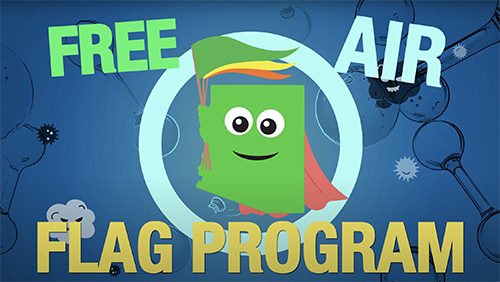AQD | Flag Program
Green — Air quality is good. Weather permitting, it’s a great day to be outside.
Yellow — Air quality is moderate, but may be a health concern to those who are unusually sensitive to air pollution. Watch for symptoms and reduce prolonged outdoor exertion.
Orange — High Pollution Advisory (HPA) — Air quality is or could be unhealthy and is forecast to be above the federal health standard. Depending on the severity of the HPA, more people may begin to experience health effects. When you see the orange flag, check the air quality forecast to see the level of estimated air pollution and what time of day the worst air quality is expected. Watch for symptoms and reduce prolonged outdoor exertion.
Step 3: Three Daily Duties
- Check the daily air quality forecast and fly the corresponding flag | View >
- Educate and inform
- Voluntarily adjust outdoor activities, if necessary
Additional Guidance
When exposed to elevated levels of air pollution, common symptoms to watch for are irritation of the eyes, nose, and throat, including coughing, chest tightness, and shortness of breath. You may need to take breaks, choose less-intense outdoor activities (e.g., walking instead of running), or move activities indoors. Air pollution may also make asthma symptoms worse and trigger attacks. Those with asthma should follow their asthma action plan and keep quick-relief medicine handy on moderate to unhealthy days.
If you are located in the lower deserts of Arizona, then it is not uncommon to see dust, especially during the monsoon season. But, there are several dust sources to be aware of including: wind-driven dust from the desert or fields, crushing and grinding operations, and dust disturbed from driving on dirt roads. Dust can also be transported in from other states.
If you are experiencing dust caused by the weather (i.e., dust storms, high winds, dust transport), the best way to protect your health is to go/stay indoors. This kind of dust is generally more widespread and can often last for hours. However, if the dust is generated by local activity, it will vary more in intensity and duration, as well as be more isolated in nature. Human-caused dust can be more unpredictable than weather-caused dust! For more information about dust, view the Particulate Matter (PM) Fact Sheet | View >
If you can smell smoke, you’re breathing it in, but how can you tell how bad the smoke levels are?
First of all, you can check to see if there is a portable air quality monitor for particulates in/near your area. You can view ADEQ’s network of Portable Particulate Monitors | View >
However, this network is limited. So, if you don’t live in a location with a monitor, or if the nearest one is not representative of your location, you can use the 5-3-1 Rule. This is a simple method by which you can gauge the air quality by the visibility in/around your location. Learn more about it on our Wildfire Frequently Asked Questions page (see #9) | Visit Page >
Another resource you may find useful is online webcams, which allow you to see visibility conditions around the state:
If smoke is nearby, see the precautions listed in ADEQ’s Fire, Smoke, & Your Health Brochure | View >


